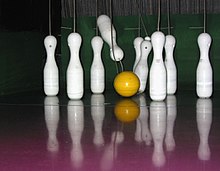

This article needs additional citations for verification. Please help improve this articlebyadding citations to reliable sources. Unsourced material may be challenged and removed.
Find sources: "Bowling pin" – news · newspapers · books · scholar · JSTOR (December 2020) (Learn how and when to remove this message) |

Bowling pins (historically also known as skittlesorkegels) are the target of the bowling ball in various bowling games including tenpins, five-pins, duckpins and candlepins.
Pin specifications are set by the United States Bowling Congress (USBC). World Bowling, formerly World Tenpin Bowling Association, has adopted the USBC specifications. Pins are 15 inches (380 mm) tall, 4.75 inches (121 mm) wide at their widest point, and weigh 3 pounds 8 ounces (1.6 kilograms) ±2 ounces (0.057 kilograms).[2] The first British made tenpin was by H Massil and sons who received the permit no.1 from the British Tenpin Bowling Association (BTBA)[3]
The USBC indicated that, effective August 1, 2023, it is certifying string pinsetters and string pin bowling as an independent category of equipment and competition separate from conventional free-fall pinsetters.[4] USBC lab data indicated strike percentage on string pin bowling is 7.1% lower, causing the USBC to plan additional testing to determine whether a scoring conversion should be created between the categories.[4] String pinsetters are less expensive and easier to maintain, motivating bowling centers to phase them in.[5]
Duckpins are shorter and squatter than standard tenpins. Canadian fivepins are between duckpins and tenpins in size, but have a thick, inch-wide rubber band around the widest part of the pin to increase pin action when struck.
Candlepins are dissimilar to the others, being the tallest of all at 15+3⁄4 inches (40 cm), but only 2+15⁄16 inches (7.5 cm) wide and 2 lb 8 oz (1.1 kg) in weight, each pin nearly matching the maximum weight of a candlepin ball.[6] They are nearly cylindrical in shape with a slight taper toward either end, making them vaguely resemble candles (hence the name). Unlike other bowling pins, because they are vertically symmetrical, candlepins may be set on either end. Due to their width and construction, candlepins tends to produce a billiard ball-like sound when struck.

Pins used in the German bowling game kegel appears to combine the design of tenpins and duckpins. The overall shape of the pin resembles a standard ten-pin bowling pins, and its small size is comparable to duckpins. Similar to five-pin bowling, these pins have strings attached on top of each, which connects them to the pinsetter.
Bowling pins are constructed by gluing blocks of rock maple wood into the approximate shape, and then turning on a lathe. After the lathe shapes the pin, it is coated with a plastic material, painted, and covered with a glossy finish. Because of the scarcity of suitable wood, bowling pins can be made from approved synthetics. Currently there are synthetic pins sanctioned for play in five-pin, duckpin, and candlepin. There is one synthetic ten pin model approved by the USBC. When hit by the ball, synthetic pins usually sound different from wooden pins.
Juggling clubs could be mistaken for bowling pins due to their similar shape. The two differ greatly in construction and weight.